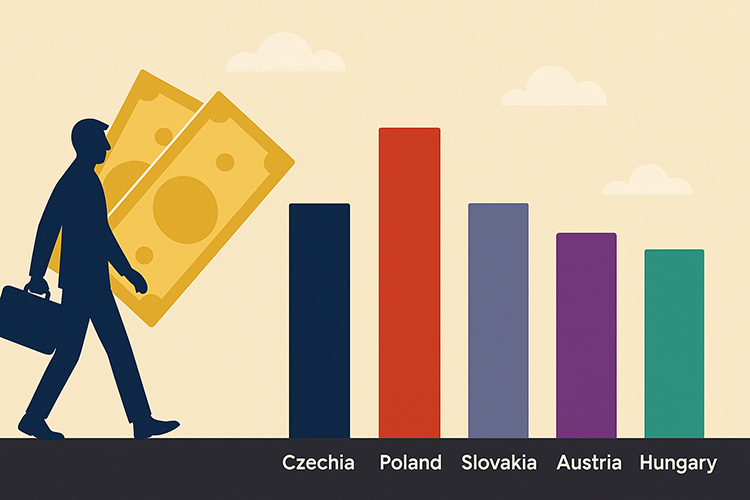Czech Wages Rise 4.25% in 2025, Logistics Leads Growth but Regional Gaps Remain
Wages in the Czech Republic are growing at an average pace of 4.25 percent this year, according to the latest survey by Grafton Recruitment. The strongest increases are being recorded in the logistics sector, where pay has risen by nearly eight percent, followed by pharmacy and healthcare with growth of just over five percent. At the other end of the scale, wages in administration, human resources, and information technology have grown more slowly, at around 3.2 percent, with IT showing signs of reaching a plateau after years of steady increases.
The survey highlights a labour market that remains tight despite global uncertainty. Inflation in the Czech Republic was measured at 2.5 percent year-on-year in August, which means wage growth is still translating into modest real gains for employees. Unemployment is around 4.5 percent, leaving many companies struggling to fill positions. Manufacturing, logistics, and service providers report the greatest difficulties, often due to the demanding nature of shift work and limited flexibility, combined with pressure to control costs.
Recruitment specialists note that high staff turnover continues to challenge employers. Many workers are prepared to leave their jobs for relatively small salary increases or better benefits offered by competitors. While two-thirds of companies surveyed say they would attempt to retain staff by raising pay by five to ten percent, only a minority of employees are persuaded to stay once they have decided to move. Some firms resist raising wages to avoid triggering wider demands across their workforce, but experts point out that the cost of recruiting and training new staff is usually higher than retaining experienced employees.
The survey also shows a gap between what workers expect and what companies provide in terms of benefits. While almost all employees now say financial benefits are important, fewer than two-thirds of office workers receive them, and the proportion is lower still for manual labourers. This mismatch continues to fuel dissatisfaction in parts of the workforce.
Regional disparities add another layer of complexity. Prague and the Central Bohemian Region remain the most competitive areas, with employers frequently negotiating individually with candidates to secure staff. In regions such as Karlovy Vary, Ústí nad Labem, and Moravian-Silesian, companies face shortages of specialists, often linked to migration of skilled workers to other parts of the country or abroad.
Data from the Czech Statistical Office show that in the second quarter of 2025 the average gross monthly wage rose by 7.8 percent year-on-year to CZK 49,402. Adjusted for inflation of 5.3 percent in the same period, this equates to real wage growth of around 2.5 percent. Experts also point out that while average gross wages remain below pre-pandemic levels, net wages are at record highs thanks to tax changes introduced in recent years.
Compared with neighbouring countries, Czech wage growth is moderate. In Poland, wages in the enterprise sector rose by around nine percent year-on-year in mid-2025, driven by strong demand in logistics, transport, and energy. Inflation there remains higher than in the Czech Republic, however, which reduces the real impact of those nominal gains. Slovakia is seeing steady but slower growth, with salaries generally lower than in Czechia but rising most strongly in logistics and industrial roles. The gap between Prague and Bratislava is narrower when adjusted for living costs.
Austria, by contrast, remains one of the highest-wage economies in Central Europe, with average gross monthly earnings above €4,300 in 2025. Wage growth has been slower than in its eastern neighbours, at around 3 percent this year, but the higher base means Austria continues to attract skilled labour from across the region. Hungary, meanwhile, reports wage growth of about 8.5 percent in the first half of 2025, among the highest in the EU. Strong increases in minimum wages and state-driven pay agreements are driving the trend, but inflation—still above 5 percent—erodes some of the benefits. Sectors such as automotive and logistics are leading the gains, although labour shortages are common across the economy.
Taken together, the picture shows a Czech economy where wages are rising more slowly than in Poland and Hungary but faster than in Austria. Real incomes are improving modestly, but regional disparities and sectoral gaps remain a challenge. Employers continue to struggle to balance wage demands with competitiveness, and without further structural reforms in housing, training, and labour mobility, the pressures in the Czech labour market are likely to persist.









